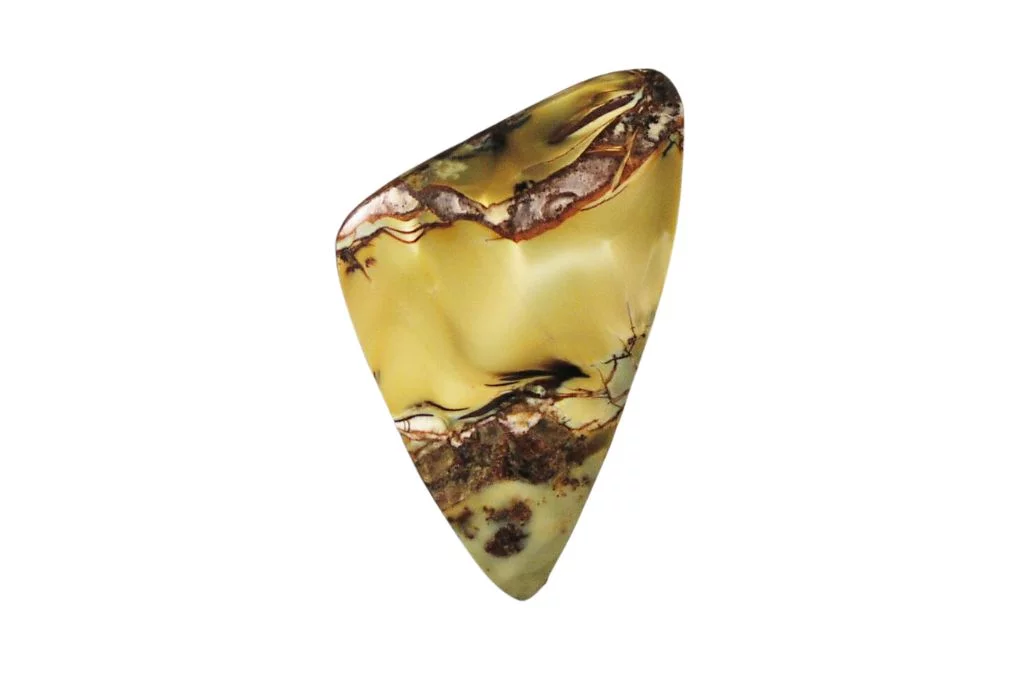Color and Appearance of Arizona Tiger’s Eye
Arizona Tiger’s Eye exhibits a striking golden-brown color with shimmering bands of light that create a captivating cat’s eye effect. This unique optical phenomenon, known as chatoyancy, is one of the most distinguishing features of this gemstone. The interplay of light across its surface produces a silky, lustrous sheen that seems to move as the stone is rotated, resembling the watchful eye of a tiger.
Structure and Composition
The crystal structure of Arizona Tiger’s Eye is composed of parallel fibers of quartz interwoven with crocidolite, a type of asbestos mineral. This fibrous structure is responsible for the stone’s chatoyant effect. Over time, the crocidolite is replaced by quartz through a process called pseudomorphism, while retaining its original fibrous form. This transformation results in the stone’s durability and unique optical properties.
Notable Physical Characteristics
Arizona Tiger’s Eye typically forms in masses or nodules, rather than well-defined crystals. It has a vitreous to silky luster and a hardness of 7 on the Mohs scale, making it quite resistant to scratches and wear. The stone often displays a banded or striped appearance, with alternating layers of golden-brown and darker hues running parallel to the direction of the fibers.
Unique Aspects and Features
What sets Arizona Tiger’s Eye apart from its counterparts found in other locations is its distinctive coloration. The golden-brown hues are often richer and more intense, attributed to the specific mineral composition of its formation environment in Arizona. Additionally, some specimens may exhibit hints of red or blue, adding to their allure. The stone’s ability to display a sharp, well-defined cat’s eye effect is particularly prized among collectors and jewelry enthusiasts.
Historical and Cultural Significance
Arizona Tiger’s Eye, also known as Desert Tiger’s Eye or Mookaite Jasper, has been revered by indigenous cultures in the American Southwest for centuries. Native American tribes, particularly the Navajo and Hopi, have incorporated this stone into their spiritual practices and artwork. The golden-brown bands reminiscent of a tiger’s eye were believed to represent the connection between the earthly realm and the spirit world.
Metaphysical Associations
In the realm of crystal healing and metaphysics, Arizona Tiger’s Eye is associated with grounding and protection. It is thought to enhance personal power, boost self-confidence, and promote mental clarity. Many practitioners believe that this stone can help balance the lower chakras, particularly the root and solar plexus chakras, fostering a sense of stability and inner strength.
Common Uses and Applications
Arizona Tiger’s Eye is widely used in jewelry making, often fashioned into pendants, bracelets, and earrings. Its striking golden-brown color and chatoyant effect make it a popular choice for both men’s and women’s accessories. In addition to adornment, the stone is frequently employed in meditation practices, where it is held or placed on the body to promote focus and clarity. Some people carry small tumbled stones as worry stones or place larger specimens in their living spaces to create a protective energy field.
Believed Benefits
Proponents of crystal healing attribute numerous benefits to Arizona Tiger’s Eye. It is said to enhance willpower, stimulate motivation, and boost personal drive. The stone is believed to aid in decision-making processes by providing mental clarity and reducing anxiety. Some individuals use it to promote financial abundance and career success, while others rely on its purported ability to ward off negative energies and protect against psychic attacks. In emotional healing, Arizona Tiger’s Eye is thought to help release fear and promote emotional balance, making it a valuable tool for those dealing with stress or trauma.

